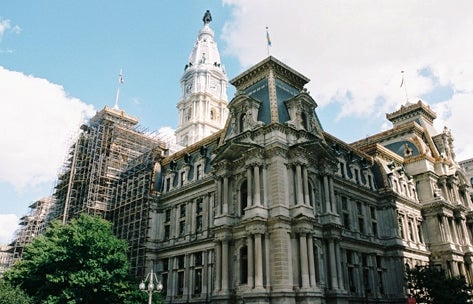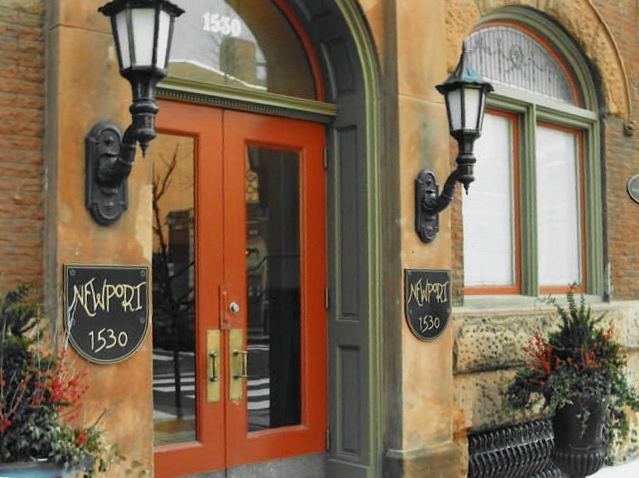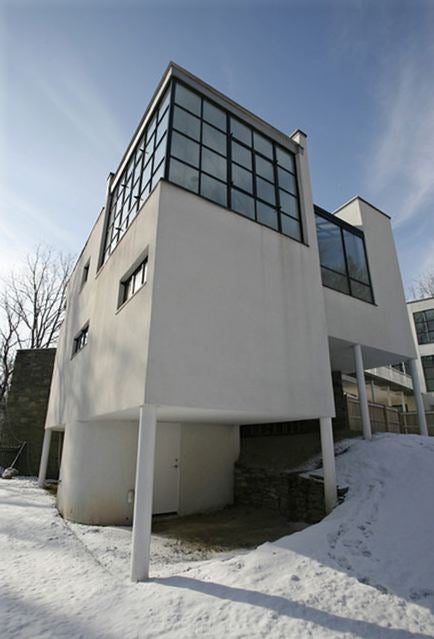Meet our preservation heroes

May 11
Watch videos of the awards ceremony below
By Alan Jaffe
For PlanPhilly
An unusually high number of well-deserved nominations this year resulted in a record number of Preservation Achievement Awards, which were presented Monday at the Park Hyatt at the Bellevue during a ceremony graced by Mayor Michael Nutter.
The Preservation Alliance of Greater Philadelphia honored 20 projects with its Grand Jury Awards, in addition to five Special Recognition Awards for individuals and organizations. The Preservation Alliance received 32 submissions for award consideration.
“Normally we give eight to ten awards, but there were so many this year that were so good, we’re giving 20 awards,” said John Gallery, executive director of the Preservation Alliance. “We also are giving out more regional awards than normal,” said Gallery, noting three winners in Wilmington and one in South Jersey.
The awards were started 16 years ago by the Preservation Coalition, one of two organizations that merged to form the Preservation Alliance. The program initially recognized projects that had been completed in the previous year. Awards for organizations and individuals, including the James Biddle Award for lifetime achievement, were added over the years. An independent jury of preservation experts from throughout the region and from many perspectives reviews the nominations.
“Most of the awards are for restoration. So it’s really about looking at the scope of the project,” Gallery said. “Was it more than a maintenance job? How well was it carried out? Was it historically faithful and accurate?”
But the criteria go “beyond bricks and mortar,” he said. Planning excellence is also judged. So is impact. “How did the project benefit its community? Does it further preservation in some way?”
One of the more unusual Grand Jury winners is the Eastern State Penitentiary Synagogue, in the Fairmount section of Philadelphia, which opened to public tours in April. The award honors Milner + Carr Conservation LLC, McKee’s Siding Inc., Hatzel & Buehler Inc., Schneider Restorations Inc., and Munn Roofing Corp., for the restoration of the synagogue established in the 1920s in the penitentiary, which is a National Historic Landmark built in the 1820s. Efforts to open the synagogue began after University of Pennsylvania students researched Jewish life at the prison and conducted an archaeological investigation of the site. Milner + Carr reconstructed the ornamental ceiling, restored the original finishes on wooden doors, benches and ark, and fabricated decorative sconces and the Eternal Light using historic photos.
Sally Elk, executive director of Eastern State Penitentiary Historic Site Inc., explained that the prison synagogue, which had suffered extreme water damage, had not been a top priority for the organization. The primary goals for the site were based on building the tour program and public safety. Once the decision was made to restore the synagogue rather than let it continue to get worse, the next question was, how far to go? “Our overall philosophy is to stabilize the ruin with selective restoration,” based on what would be pertinent to the interpretive program at the site. They decided on full restoration.
The next challenge was funding. The research into the history of the synagogue revealed two primary volunteers from the community who counseled the inmates and helped them celebrate their faith, Elk said. “We realized this was more than a synagogue story; it was a story of volunteerism and spirituality.” The descendants of those volunteers were “compelled by the story” and provided funding for the synagogue’s restoration.
The Please Touch Museum is a recipient of a Grand Jury Award for the excellent reuse of a city landmark, Memorial Hall in Fairmount Park. The award honors Northstar Advisors LLC, Kise Straw & Kolodner, Bala Consulting Engineer Inc., Design + Communication Inc., Keating Bittenbender McCrae, and Grenald Waldron Associates.
The $88 million restoration and reuse project took six years from concept to grand opening last October. The hall was designed as the Fine Arts Building of the 1876 Centennial Exposition, and then served as the original Philadelphia Museum of Art, a recreation center, police station, recording studio, and Fairmount Park Commission headquarters. The building had closed in 2000 after years of neglect and substandard alterations. The exterior restoration included cleaning the granite, replacing carved stone, designing new windows based on original configurations, and new wood doors based on historic photos. Damage from roof leaks required restoration of plaster and metal ornaments, and many of the marble floor stones were reset.
The project returns one of the city’s most distinctive structures to active use for a new generation of visitors.
“A lot of people were concerned that a treasure like Memorial Hall would be turned over to a lot of noisy children,” said Nancy Kolb, director of the Please Touch Museum. “And they feared we wouldn’t know what we were doing.” The formation of a preservation committee, which included John Gallery, guided the museum through the design process. “We had to make compromises, but we worked through them,” Kolb said. Representatives from the state, Fairmount Park, and the federal government collaborated on the project, “and what you see is a labor of love of a whole lot of people. … It took longer to restore – about three and half years – than the 18 months it took to build. But now we have a lasting legacy for the city.”
The award to the Philadelphia City Hall restoration comes 18 years after the project began. It honors the city’s Department of Public Property, Kelly/Maiello Inc., VITETTA, Marianna Thomas Architects, Keast & Hood Co., Vinokur-Pace Engineering Services, Inc., Nortion Art Conservation Inc., Stephen McLaughlin Roofing Consultant, C.B. Development Services Inc., Daniel Keating Co., Avalotis, Lepore/Mark Inc., Hamada Roofing Inc. Crescent Iron Works, Window Repair & Restoration LLC, and Clad Sheet Metal LLC.
The preservation of City Hall, which had been built over 30 years beginning in 1871, started with the selection of a multi-disciplinary team in 1991. The team remained with the project through all its stages and through three mayoral administrations. “One of the most interesting things is that this project started when Rendell was mayor,” Gallery said, and was continued by John Street and Michael Nutter. “It’s unusual to have a capital improvement project of that size that inspires all three mayors to maintain their commitment to it.”
From 1994 to 1998, demonstration projects were conducted in the northeast quadrant to determine the best methods of restoration and preservation. Restoration then proceeded counterclockwise around the building. More than 250 marble carvings by Alexander Milne Calder, bas relief carvings and other embellishments were cleaned and restored. The main flat roof was replaced, and rusting cresting was cleaned and repainted. Some cast-iron sections were repaired or replaced, and hundreds of windows were restored.
Aside from the funding commitment, the greatest challenge for the City Hall project has been the “never-ending scaffolding” and the invasive nature of the work on the sidewalks around the building, said Joan Schlotterbeck, commissioner of the Department of Public Property. “The citizens put up with a lot.”
Throughout the process, there were “many surprises,” she said. “We found a lot of structural issues that had to be dealt with. But anything we discovered, we fixed. I call this building a beautiful wedding cake with many layers,” and those layers required recasting molds for many of the sculptures and carvings. And many layers of pigeon guano that had to be removed.
Schlotterbeck predicted another 18 months of work on the interior courtyard before the job is done. But the finished portions have been very successful, she said. “All we get is praise, and this award is evidence of that.”
The award to the Chinatown Friendship Gate is for an extraordinary, international effort. It honors the city Development of Public Property, Chinatown Development Corp., International Visitors Council, Yao C. Huang AIA, Sabrina Soong AIA, Watts Restoration Inc., Superior Scaffold Services, Dietz & Watson Inc., Liu Jie, Liu Jinduo, Su Jingwang, Zhang Qin, Lian Xueping, and Sun Yundong.
The Friendship Gate on 10th Street in Chinatown was dedicated in 1984 and at the time was the largest and most classically authentic ceremonial Friendship Gate in the U.S. After decades of harsh weather, it needed structural stabilization and replacement of tiles, which was completed in 2004. The second phase focused on removing paint, wood repairs and repainting. Craftsmen from Tianjin used centuries-old methods, including application of gold leaf. Pigs’ blood was needed in the traditional paint mixture, so it was shipped to Philadelphia from the North Carolina plant of Dietz & Watson. The blood was stored in the City Morgue because its freezer was large enough to accommodate the amount needed. The paint’s base was created by boiling Tung oil in a giant wok in an open field on the riverfront and mixing it with the blood. A traditional, heavy rice paper was used to transfer the Chinese patterns onto the gate for repainting. The second phase was completed last October.
The award to the Philadelphia Museum of Art recognizes the innovation that went into a major renovation while keeping the building open to the public, Gallery explained. The award honors VITETTA, Keast & Hood Co., Kreilick Conservation LLC, Architectural Testing, Landmarks Facilities Group Inc., Pennoni Associates Inc., Hughes Associates Inc., L.F. Driscoll Co., Lepore/Mark Inc., Thomas Roofing Company, Warren Lightning Protection, A.T. Chadwick Co. Inc. Metalan, ThyssenKrupp Safway Inc., Historical Arts & Casting Inc., and Criterion Labs Inc.
Decades of deferred maintenance on the 1928 structure had taken its toll on the exterior. Beginning in 2005, assessments and tests were conducted to determine the preservation treatments. Stopping water infiltration was the top job. To seal the terra-cotta roof, 2,000 feet of metal gutters and valleys were replaced and a new drain system was installed. Joints in the limestone façade were repointed, and some massive blocks were replaced. The masonry cleaning involved water misting, biocide, steam, mild detergent, or low-pressure water wash, depending on conditions. Column capitals were cleaned with “backpack lasers.” Full-size blueprints were draped on the scaffolding to interpret the work for the public.
The award to Mother Bethel A.M.E. Church is a testament to its congregation. It honors Atkin Olshin Schade Architects, 1:1:6 Technologies Inc., Keast & Hood Co., Premier Building Restoration Inc., The Temple Group, and Wolf Historic Preservation.
Mother Bethel African Methodist Episcopal Church, 6th and Lombard Streets, is a National Historic Landmark and is believed to be the oldest continuously black-owned property in the country. The current 1890 building designed by Hazelhurst & Huckel is the fourth church on the site.
Worsening exterior conditions of the building, caused mainly by water infiltration through the roof, threatened the sanctuary in 2006. Among the most impressive subsequent work was the replacement of the slate roof, rebuilding of the four pinnacles of the steeple and installation of a new cross, and the removal of protective window coverings to reveal the stained glass windows.
“The congregation raised $28 million to do the work, which was an astonishing challenge. It is one of the most important African-American historic sites in the city, and it looks amazing,” Gallery said.
The other Grand Jury award winners are:
• 832 Lombard St., Philadelphia (Masada Custom Builders) for the restoration and adaptive reuse of an abandoned Philadelphia church into a private residence.
_______________________________________________
• Arcadia University, Glenside, Pa., for the restoration of an architecturally distinctive tower and roof.
_______________________________________________
_______________________________________________
• Bryn Mawr Film Institute for the rehabilitation and restoration of a 1926 movie theater and a return to its original use.
_______________________________________________
• Crane Stable, Philadelphia (Crane Arts LLC) for restoration and adaptive reuse of a long-vacant 1905 stable.
_______________________________________________
• Hargroves House, Philadelphia (Greene Street Friends School) for restoration of an 1833 frame house, now used for school offices.
_______________________________________________
_______________________________________________
• Hatboro Lofts, Hatboro, Pa. (Plumridge LP) for restoration and adaptive reuse of 1920s factory buildings into residential buildings.
_______________________________________________
• Historic Smithville, Mt. Holly, N.J. (Burlington County Board of Chosen Freeholders) for ongoing preservation of an intact Victorian-era industrial village.
_______________________________________________
• Hoffman Studio, Wayne, Pa. (David Hoffman) for rehabilitation of a 1905 electrical substation into a “green” living and working space.
_______________________________________________
• The Lippincott, Wilmington, Del. (Market-Preservation Associates LLC) for rehabilitation of a rundown, 19th-century block in the downtown.
_______________________________________________
_______________________________________________
• Nemours Mansion and Gardens, Wilmington, Del. (Nemours Foundation) for the extensive restoration of the 1910 Alfred I. DuPont estate.
_______________________________________________

• The Newport, Philadelphia (Spruce 1520 LLC) for the restoration and renovation of the 1897 apartment building, one of Philadelphia’s earliest high-rises.
_______________________________________________
• Philadelphia Rowhouse Manual (Philadelphia City Planning Commission) a 48-page publication on how owners can adapt their rowhouse for modern living without compromising basic form and architecture.
_______________________________________________

• Spreter Studio, Gladwyne (Michael and Karen Sprewak) for restoration of a small International Style structure and construction of a sympathetic new addition.
_______________________________________________
• Van Amringe Building, Delaware City, Del. (The City of Delaware City) for stabilization and exterior restoration of a decrepit 1830 building.
_______________________________________________
The 2009 Special Recognition Award winners are:
• Hyman Myers, FAIA of VITETTA, recipient of the James Biddle Award, recognizing lifetime achievement in historic preservation. Myers’ long career as a preservation architect includes restoration of the Pennsylvania Academy of the Fine Arts.
• Nancy Kolb, president and CEO of the Please Touch Museum, recipient of the Public Service Award in recognition of her indefatigable determination in the restoration and reuse of Memorial Hall as the new home of the museum.
• Eastern State Penitentiary Historic Site, Inc., recipient of the Board of Directors Award, for its exceptional stewardship of the National Historic Landmark prison.
• George Hoessel, a longtime and dedicated Preservation Alliance volunteer, recipient of the Rhoda and Permar Richards Award for service to the Alliance.
• The Historical Society of Frankford’s Center for Northeast Philadelphia History,
Historic Germantown and the Chester County Historic Preservation Network, recipients of Community Action Awards for achievement by community organizations.
Contact the reporter at alanjaffe@mac.com
WHYY is your source for fact-based, in-depth journalism and information. As a nonprofit organization, we rely on financial support from readers like you. Please give today.



